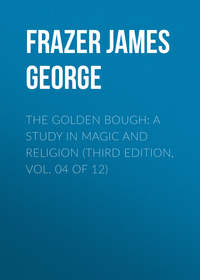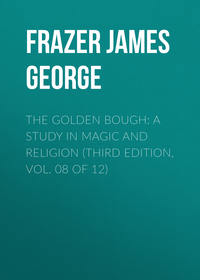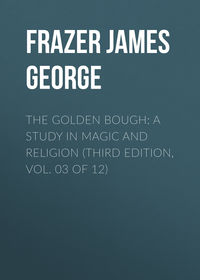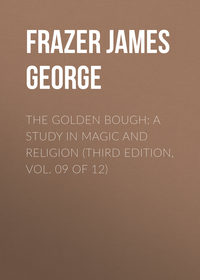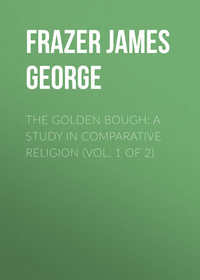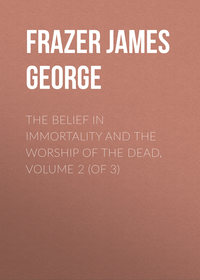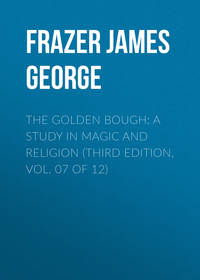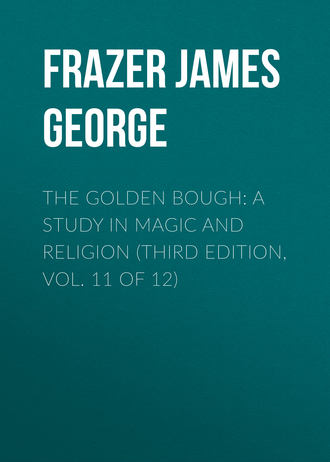 полная версия
полная версияThe Golden Bough: A Study in Magic and Religion (Third Edition, Vol. 11 of 12)
The external soul in Basque, Kabyle, and Magyar stories.
A Basque story, which closely resembles some of the stories told among Aryan peoples, relates how a monster – a Body-without-Soul – detains a princess in captivity, and is questioned by her as to how he might be slain. With some reluctance he tells her, “You must kill a terrible wolf which is in the forest, and inside him is a fox, in the fox is a pigeon; this pigeon has an egg in his head, and whoever should strike me on the forehead with this egg would kill me.” The hero of the story, by name Malbrouk, has learned, in the usual way, the art of turning himself at will into a wolf, an ant, a hawk, or a dog, and on the strength of this accomplishment he kills the animals, one after the other, and extracts the precious egg from the pigeon's head. When the wolf is killed, the monster feels it and says despondently, “I do not know if anything is going to happen to me. I am much afraid of it.” When the fox and the pigeon have been killed, he cries that it is all over with him, that they have taken the egg out of the pigeon, and that he knows not what is to become of him. Finally the princess strikes the monster on the forehead with the egg, and he falls a corpse.384 In a Kabyle story an ogre declares that his fate is far away in an egg, which is in a pigeon, which is in a camel, which is in the sea. The hero procures the egg and crushes it between his hands, and the ogre dies.385 In a Magyar folk-tale, an old witch detains a young prince called Ambrose in the bowels of the earth. At last she confided to him that she kept a wild boar in a silken meadow, and if it were killed, they would find a hare inside, and inside the hare a pigeon, and inside the pigeon a small box, and inside the box one black and one shining beetle: the shining beetle held her life, and the black one held her power; if these two beetles died, then her life would come to an end also. When the old hag went out, Ambrose killed the wild boar, and took out the hare; from the hare he took the pigeon, from the pigeon the box, and from the box the two beetles; he killed the black beetle, but kept the shining one alive. So the witch's power left her immediately, and when she came home, she had to take to her bed. Having learned from her how to escape from his prison to the upper air, Ambrose killed the shining beetle, and the old hag's spirit left her at once.386 In another Hungarian story the safety of the Dwarf-king resides in a golden cockchafer, inside a golden cock, inside a golden sheep, inside a golden stag, in the ninety-ninth island. The hero overcomes all these golden animals and so recovers his bride, whom the Dwarf-king had carried off.387
The external soul in a Lapp story. The giant whose life was in a hen's egg. The helpful animals.
A Lapp story tells of a giant who slew a man and took away his wife. When the man's son grew up, he tried to rescue his mother and kill the giant, but fire and sword were powerless to harm the monster; it seemed as if he had no life in his body. “Dear mother,” at last enquired the son, “don't you know where the giant has hidden away his life?” The mother did not know, but promised to ask. So one day, when the giant chanced to be in a good humour, she asked him where he kept his life. He said to her, “Out yonder on a burning sea is an island, in the island is a barrel, in the barrel is a sheep, in the sheep is a hen, in the hen is an egg, and in the egg is my life.” When the woman's son heard this, he hired a bear, a wolf, a hawk, and a diver-bird and set off in a boat to sail to the island in the burning sea. He sat with the hawk and the diver-bird under an iron tent in the middle of the boat, and he set the bear and the wolf to row. That is why to this day the bear's hair is dark brown and the wolf has dark-brown spots; for as they sat at the oars without any screen they were naturally scorched by the tossing tongues of flame on the burning sea. However, they made their way over the fiery billows to the island, and there they found the barrel. In a trice the bear had knocked the bottom out of it with his claws, and forth sprang a sheep. But the wolf soon pulled the sheep down and rent it in pieces. From out the sheep flew a hen, but the hawk stooped on it and tore it with his talons. In the hen was an egg, which dropped into the sea and sank; but the diver-bird dived after it. Twice he dived after it in vain and came up to the surface gasping and spluttering; but the third time he brought up the egg and handed it to the young man. Great was the young man's joy. At once he kindled a great bonfire on the shore, threw the egg into it, and rowed away back across the sea. On landing he went away straight to the giant's abode, and found the monster burning, just as he had left the egg burning on the island. “Fool that I was,” lamented the dying giant, “to betray my life to a wicked old woman,” and with that he snatched at an iron tube through which in happier days he had been wont to suck the blood of his human victims. But the woman was too subtle for him, for she had taken the precaution of inserting one end of the tube in the glowing embers of the hearth; and so, when the giant sucked hard at the other end, he imbibed only fire and ashes. Thus he burned inside as well as outside, and when the fire went out the giant's life went out with it.388
The external soul in Samoyed and Kalmuck stories.
A Samoyed story tells how seven warlocks killed a certain man's mother and carried off his sister, whom they kept to serve them. Every night when they came home the seven warlocks used to take out their hearts and place them in a dish which the woman hung on the tent-poles. But the wife of the man whom they had wronged stole the hearts of the warlocks while they slept, and took them to her husband. By break of day he went with the hearts to the warlocks, and found them at the point of death. They all begged for their hearts; but he threw six of their hearts to the ground, and six of the warlocks died. The seventh and eldest warlock begged hard for his heart and the man said, “You killed my mother. Make her alive again, and I will give you back your heart.” The warlock said to his wife, “Go to the place where the dead woman lies. You will find a bag there. Bring it to me. The woman's spirit is in the bag.” So his wife brought the bag; and the warlock said to the man, “Go to your dead mother, shake the bag and let the spirit breathe over her bones; so she will come to life again.” The man did as he was bid, and his mother was restored to life. Then he hurled the seventh heart to the ground, and the seventh warlock died.389 In a Kalmuck tale we read how a certain khan challenged a wise man to shew his skill by stealing a precious stone on which the khan's life depended. The sage contrived to purloin the talisman while the khan and his guards slept; but not content with this he gave a further proof of his dexterity by bonneting the slumbering potentate with a bladder. This was too much for the khan. Next morning he informed the sage that he could overlook everything else, but that the indignity of being bonneted with a bladder was more than he could stand; and he ordered his facetious friend to instant execution. Pained at this exhibition of royal ingratitude, the sage dashed to the ground the talisman which he still held in his hand; and at the same instant blood flowed from the nostrils of the khan, and he gave up the ghost.390
The external soul in Tartar poems.
In a Tartar poem two heroes named Ak Molot and Bulat engage in mortal combat. Ak Molot pierces his foe through and through with an arrow, grapples with him, and dashes him to the ground, but all in vain, Bulat could not die. At last when the combat has lasted three years, a friend of Ak Molot sees a golden casket hanging by a white thread from the sky, and bethinks him that perhaps this casket contains Bulat's soul. So he shot through the white thread with an arrow, and down fell the casket. He opened it, and in the casket sat ten white birds, and one of the birds was Bulat's soul. Bulat wept when he saw that his soul was found in the casket. But one after the other the birds were killed, and then Ak Molot easily slew his foe.391 In another Tartar poem, two brothers going to fight two other brothers take out their souls and hide them in the form of a white herb with six stalks in a deep pit. But one of their foes sees them doing so and digs up their souls, which he puts into a golden ram's horn, and then sticks the ram's horn in his quiver. The two warriors whose souls have thus been stolen know that they have no chance of victory, and accordingly make peace with their enemies.392 In another Tartar poem a terrible demon sets all the gods and heroes at defiance. At last a valiant youth fights the demon, binds him hand and foot, and slices him with his sword. But still the demon is not slain. So the youth asked him, “Tell me, where is your soul hidden? For if your soul had been hidden in your body, you must have been dead long ago.” The demon replied, “On the saddle of my horse is a bag. In the bag is a serpent with twelve heads. In the serpent is my soul. When you have killed the serpent, you have killed me also.” So the youth took the saddle-bag from the horse and killed the twelve-headed serpent, whereupon the demon expired.393 In another Tartar poem a hero called Kök Chan deposits with a maiden a golden ring, in which is half his strength. Afterwards when Kök Chan is wrestling long with a hero and cannot kill him, a woman drops into his mouth the ring which contains half his strength. Thus inspired with fresh force he slays his enemy.394
The external soul in a Mongolian story and Tartar poems.
In a Mongolian story the hero Joro gets the better of his enemy the lama Tschoridong in the following way. The lama, who is an enchanter, sends out his soul in the form of a wasp to sting Joro's eyes. But Joro catches the wasp in his hand, and by alternately shutting and opening his hand he causes the lama alternately to lose and recover consciousness.395 In a Tartar poem two youths cut open the body of an old witch and tear out her bowels, but all to no purpose, she still lives. On being asked where her soul is, she answers that it is in the middle of her shoe-sole in the form of a seven-headed speckled snake. So one of the youths slices her shoe-sole with his sword, takes out the speckled snake, and cuts off its seven heads. Then the witch dies.396 Another Tartar poem describes how the hero Kartaga grappled with the Swan-woman. Long they wrestled. Moons waxed and waned and still they wrestled; years came and went, and still the struggle went on. But the piebald horse and the black horse knew that the Swan-woman's soul was not in her. Under the black earth flow nine seas; where the seas meet and form one, the sea comes to the surface of the earth. At the mouth of the nine seas rises a rock of copper; it rises to the surface of the ground, it rises up between heaven and earth, this rock of copper. At the foot of the copper rock is a black chest, in the black chest is a golden casket, and in the golden casket is the soul of the Swan-woman. Seven little birds are the soul of the Swan-woman; if the birds are killed the Swan-woman will die straightway. So the horses ran to the foot of the copper rock, opened the black chest, and brought back the golden casket. Then the piebald horse turned himself into a bald-headed man, opened the golden casket, and cut off the heads of the seven birds. So the Swan-woman died.397 In a Tartar story a chief called Tash Kan is asked where his soul is. He answers that there are seven great poplars, and under the poplars a golden well; seven Maralen (?) come to drink the water of the well, and the belly of one of them trails on the ground; in this Maral is a golden box, in the golden box is a silver box, in the silver box are seven quails, the head of one of the quails is golden and its tail silver; that quail is Tash Kan's soul. The hero of the story gets possession of the seven quails and wrings the necks of six of them. Then Tash Kan comes running and begs the hero to let his soul go free. But the hero wrings the last quail's neck, and Tash Kan drops dead.398 In another Tartar poem the hero, pursuing his sister who has driven away his cattle, is warned to desist from the pursuit because his sister has carried away his soul in a golden sword and a golden arrow, and if he pursues her she will kill him by throwing the golden sword or shooting the golden arrow at him.399
The external soul in a Chinese story.
A modern Chinese story tells how an habitual criminal used to take his soul out of his own body for the purpose of evading the righteous punishment of his crimes. This bad man lived in Khien (Kwei-cheu), and the sentences that had been passed on him formed a pile as high as a hill. The mandarins had flogged him to death with sticks and flung his mangled corpse into the river, but three days afterwards the scoundrel got his soul back again, and on the fifth day he resumed his career of villainy as if nothing had happened. The thing occurred again and again, till at last it reached the ears of the Governor of the province, who flew into a violent passion and proposed to the Governor-General to have the rascal beheaded. And beheaded he was; but in three days the wretch was alive again with no trace of decapitation about him except a slender red thread round his neck. And now, like a giant refreshed, he began a fresh series of enormities. He even went so far as to beat his own mother. This was more than she could bear, and she brought the matter before the magistrate. She produced in court a vase and said, “In this vase my refractory son has hidden his soul. Whenever he was conscious of having committed a serious crime, or a misdeed of the most heinous kind, he remained at home, took his soul out of his body, purified it, and put it in the vase. Then the authorities only punished or executed his body of flesh and blood, and not his soul. With his soul, refined by a long process, he then cured his freshly mutilated body, which thus became able in three days to recommence in the old way. Now, however, his crimes have reached a climax, for he has beaten me, an old woman, and I cannot bear it. I pray you, smash this vase, and scatter his soul by fanning it away with a windwheel; and if then you castigate his body anew, it is probable that bad son of mine will really die.” The mandarin took the hint. He had the rogue cudgelled to death, and when they examined the corpse they found that decay had set in within ten days.400
The external soul in a story told by the Khasis of Assam.
The Khasis of Assam tell of a certain Kyllong, king of Madur, who pursued his conquests on a remarkable principle. He needed few or no soldiers, because he himself was a very strong man and nobody could kill him permanently; they could, it is true, put him to death, but then he came to life again immediately. The king of Synteng, who was much afraid of him, once chopped him in pieces and threw the severed hands and feet far away, thinking thus to get rid of him for good and all; but it was to no purpose. The very next morning Kyllong came to life again and stalked about as brisk as ever. So the king of Synteng was very anxious to learn how his rival contrived thus to rise from the dead; and he hit on a plan for worming out the secret. He chose the fairest girl of the whole country, clad her in royal robes, put jewels of gold and silver upon her, and said, “All these will I give thee and more besides, if thou canst obtain for me King Kyllong's secret, and canst inform me how he brings himself to life again after being killed.” So he sent the girl to the slave-market in King Kyllong's country; and the king saw and loved her and took her to wife. So she caressed him and coaxed him to tell her his secret, and in a fatal hour he was beguiled into revealing it. He said, “My life depends upon these things. I must bathe every day and must wash my entrails. After that, I take my food, and there is no one on earth who can kill me unless he obtains possession of my entrails. Thus my life hangs only on my entrails.” His treacherous wife at once sent word to the king of Synteng, who caused men to lie in wait while Kyllong was bathing. As usual, Kyllong had laid his entrails on one side of the bathing-place, while he disported himself in the water, intending afterwards to wash them and replace them in his body. But before he could do so, one of the liers-in-wait had seized the entrails and killed him. The entrails he cut in pieces and gave to the dogs to eat. That was the end of King Kyllong. He was never able to come to life again; his country was conquered, and the members of the royal family were scattered far and wide. Seven generations have passed since then.401
The external soul in a Malay poem. Bidasari and the golden fish.
A Malay poem relates how once upon a time in the city of Indrapoora there was a certain merchant who was rich and prosperous, but he had no children. One day as he walked with his wife by the river they found a baby girl, fair as an angel. So they adopted the child and called her Bidasari. The merchant caused a golden fish to be made, and into this fish he transferred the soul of his adopted daughter. Then he put the golden fish in a golden box full of water, and hid it in a pond in the midst of his garden. In time the girl grew to be a lovely woman. Now the King of Indrapoora had a fair young queen, who lived in fear that the king might take to himself a second wife. So, hearing of the charms of Bidasari, the queen resolved to put her out of the way. She lured the girl to the palace and tortured her cruelly; but Bidasari could not die, because her soul was not in her. At last she could stand the torture no longer and said to the queen, “If you wish me to die, you must bring the box which is in the pond in my father's garden.” So the box was brought and opened, and there was the golden fish in the water. The girl said, “My soul is in that fish. In the morning you must take the fish out of the water, and in the evening you must put it back into the water. Do not let the fish lie about, but bind it round your neck. If you do this, I shall soon die.” So the queen took the fish out of the box and fastened it round her neck; and no sooner had she done so, than Bidasari fell into a swoon. But in the evening, when the fish was put back into the water, Bidasari came to herself again. Seeing that she thus had the girl in her power, the queen sent her home to her adopted parents. To save her from further persecution her parents resolved to remove their daughter from the city. So in a lonely and desolate spot they built a house and brought Bidasari thither. There she dwelt alone, undergoing vicissitudes that corresponded with the vicissitudes of the golden fish in which was her soul. All day long, while the fish was out of the water, she remained unconscious; but in the evening, when the fish was put into the water, she revived. One day the king was out hunting, and coming to the house where Bidasari lay unconscious, was smitten with her beauty. He tried to waken her, but in vain. Next day, towards evening, he repeated his visit, but still found her unconscious. However, when darkness fell, she came to herself and told the king the secret of her life. So the king returned to the palace, took the fish from the queen, and put it in water. Immediately Bidasari revived, and the king took her to wife.402
The external soul in a story told in Nias.
Another story of an external soul comes from Nias, an island to the west of Sumatra. Once on a time a chief was captured by his enemies, who tried to put him to death but failed. Water would not drown him nor fire burn him nor steel pierce him. At last his wife revealed the secret. On his head he had a hair as hard as a copper wire; and with this wire his life was bound up. So the hair was plucked out, and with it his spirit fled.403
The external soul in a Hausa story. The king whose life was in a box. The helpful animals.
A Hausa story from Northern Nigeria closely resembles some of the European tales which we have noticed; for it contains not only the incident of the external soul, but also the incident of the helpful animals, by whose assistance the hero is able to slay the Soulless King and obtain possession of the kingdom. The story runs thus. A certain man and his wife had four daughters born to them in succession, but every one of the baby girls mysteriously disappeared on the day when she was to be weaned; so the parents fell under the suspicion of having devoured them. Last of all there was born to them a son, who to avoid accidents was left to wean himself. One day, as he grew up, the son received a magic lotion from an old woman, who told him to rub his eyes with it. He did so, and immediately he saw a large house and entering it he found his eldest sister married to a bull. She bade him welcome and so did her husband the bull; and when he went away, the bull very kindly presented him with a lock of his hair as a keepsake. In like manner the lad discovered his other three sisters, who were living in wedlock with a ram, a dog, and a hawk respectively. All of them welcomed him and from the ram, the dog, and the hawk he received tokens of regard in the shape of hair or feathers. Then he returned home and told his parents of his adventure and how he had found his sisters alive and married. Next day he went to a far city, where he made love to the Queen and persuaded her to plot with him against the life of the King her husband. So she coaxed the King to shew his affection for her by “taking his own life, and joining it to hers.” The unsuspecting husband, as usual, fell into the trap set for him by his treacherous wife. He confided to her the secret of his life. “My life,” said he, “is behind the city, behind the city in a thicket. In this thicket there is a lake; in the lake is a rock; in the rock is a gazelle; in the gazelle is a dove; and in the dove is a small box.” The Queen divulged the secret to her lover, who kindled a fire behind the city and threw into it the hair and feathers which he had received from the friendly animals, his brothers-in-law. Immediately the animals themselves appeared and readily gave their help in the enterprise. The bull drank up the lake; the ram broke up the rock; the dog caught the gazelle; the hawk captured the dove. So the youth extracted the precious box from the dove and repaired to the palace, where he found the King already dead. His Majesty had been ailing from the moment when the young man left the city, and he grew steadily worse with every fresh success of the adventurer who was to supplant him. So the hero became King and married the false Queen; and his sisters' husbands were changed from animals into men and received subordinate posts in the government. The hero's parents, too, came to live in the city over which he reigned.404
The external soul in a South Nigerian story. The external soul in a story told by the Ba-Ronga of South Africa. The Clan of the Cat.
A West African story from Southern Nigeria relates how a king kept his soul in a little brown bird, which perched on a tall tree beside the gate of the palace. The king's life was so bound up with that of the bird that whoever should kill the bird would simultaneously kill the king and succeed to the kingdom. The secret was betrayed by the queen to her lover, who shot the bird with an arrow and thereby slew the king and ascended the vacant throne.405 A tale told by the Ba-Ronga of South Africa sets forth how the lives of a whole family were contained in one cat. When a girl of the family, named Titishan, married a husband, she begged her parents to let her take the precious cat with her to her new home. But they refused, saying, “You know that our life is attached to it”; and they offered to give her an antelope or even an elephant instead of it. But nothing would satisfy her but the cat. So at last she carried it off with her and shut it up in a place where nobody saw it; even her husband knew nothing about it. One day, when she went to work in the fields, the cat escaped from its place of concealment, entered the hut, put on the warlike trappings of the husband, and danced and sang. Some children, attracted by the noise, discovered the cat at its antics, and when they expressed their astonishment, the animal only capered the more and insulted them besides. So they went to the owner and said, “There is somebody dancing in your house, and he insulted us.” “Hold your tongues,” said he, “I'll soon put a stop to your lies.” So he went and hid behind the door and peeped in, and there sure enough was the cat prancing about and singing. He fired at it, and the animal dropped down dead. At the same moment his wife fell to the ground in the field where she was at work; said she, “I have been killed at home.” But she had strength enough left to ask her husband to go with her to her parents' village, taking with him the dead cat wrapt up in a mat. All her relatives assembled, and bitterly they reproached her for having insisted on taking the animal with her to her husband's village. As soon as the mat was unrolled and they saw the dead cat, they all fell down lifeless one after the other. So the Clan of the Cat was destroyed; and the bereaved husband closed the gate of the village with a branch, and returned home, and told his friends how in killing the cat he had killed the whole clan, because their lives depended on the life of the cat. In another Ronga story the lives of a whole clan are attached to a buffalo, which a girl of the clan in like manner insists on taking with her.406




